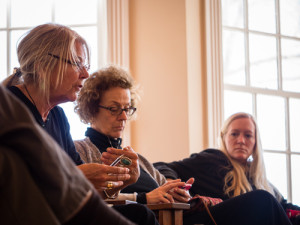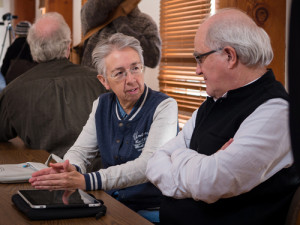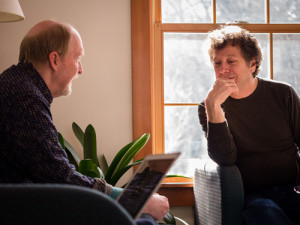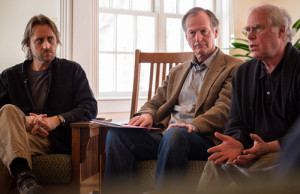
Here some clansmen learn the Dhamma—discourses, stanzas, expositions, verses, exclamations, sayings, birth stories, marvels, and answers to questions—and having learned the Dhamma, they examine the meaning of those teachings with wisdom. Examining the meaning of those teachings with wisdom, they gain a reflective acceptance of them. They do not learn the Dhamma for the sake of criticising others and for winning in debates, and they experience the good for the sake of which they learned the Dhamma. Those teachings, being rightly grasped by them, conduce to their welfare and happiness for a long time. Why is that? Because of the right grasp of those teachings….
Suppose a man in the course of a journey saw a great expanse of water, whose near shore was dangerous and fearful and whose further shore was safe and free from fear, but there was no ferryboat or bridge for going to the far shore. So the man collected grass, twigs, branches, and leaves and bound them together into a raft, and supported by the raft and making an effort with his hands and feet, he got safely across to the far shore. When that man got across and had arrived at the far shore, he might think thus: ‘This raft has been very helpful to me, since supported by it and making an effort with my hands and feet, I got safely across to the far shore. Suppose I were to haul it onto the dry land or set it adrift in the water, and then go wherever I want.’ It is by so doing that that man would be doing what should be done with that raft. So too I have shown you how the Dhamma is similar to a raft, being for the purpose of crossing over, not for the purpose of grasping.
–transl. Bhikkhu Bodhi
A conference on secular Buddhism at BCBS
Last month, some 30 people with long and deep interest in Buddhist thought and practice met at Barre Center for Buddhist Studies. All of them have taught Buddhism in one form or another for decades—some as academics, some as former monastics, all as scholar-practitioners. Together they represent all three “turnings of the wheel,” from the Theravāda through Mahāyāna and Vajrayāna, and thus the three largest groups of practitioners in the West: Theravadan, Zen and Tibetan. They came from as far as Australia and Israel, bringing formal training in linguistics, neuroscience, philosophy, psychology or religious studies. More than half are published authors. Most of them already knew several of their fellow conferees, but knew others only by reputation. Needless to say, there was no shortage of interesting conversation.
No one needed convincing about the importance of the issues under the working title, “secular Buddhism.” As one participant noted, just as we need to keep redefining “democracy” we need to do the same with Buddhism. They pursued that definition through twenty-two formal presentations, about a dozen topical discussion groups, and much informal but fruitful talk over the course of three days. They wrestled with the reality that the Buddhist traditions from which we have drawn our practices, ethics and philosophies are not automatically compatible—as traditionally understood and practiced—with science, rationality, and twenty-first century culture.

New rafts: How did the need arise?
When the nineteenth-century German philosopher Nietzsche declared “God is dead,” he was not exulting, but rather warning us that science and pure rationality had removed the focal point, the perspective, that religion had been providing, and that we had not found a suitable replacement.
A similar realization is now front and center for some Western Buddhists. They are attracted by what they see, inherent in the Dharma, as the potential for an atheistic or “post-theistic” solution to the human existential problem. They believe it can provide the focal point for a human life without seeking to remove science from authority over its domain. They want to throw out the metaphysical, dogmatic bathwater without losing the sacred baby. They hope to retain the kind of whole-life role Buddhism has had in its traditional cultures, without insistence on fundamentalist dogma, the limitations of monastic hierarchy, or negative cultural practices such as gender discrimination. In other words, there is a lot of work to do—but they see no alternative.
Before the nineteenth century, Buddhist teachings moved slowly, over generations, travelling to new countries and kingdoms in the minds and the rucksacks of wandering teachers crossing mountains on foot. Today, science, technology, and the increasingly global changes in culture that spring from them, have created radically new environments, new rivers for Buddhist teachings to cross.
Threshold questions
Are there teachings of the Buddha that can be compatible? What would those teachings be? Can they retain the vital essence of Gotama’s teachings? How should they be articulated? How should people who develop these new articulations explain themselves, and relate to those who practice traditional forms? How should they relate to the contemporary world?
In light of these broad threshold questions, the presentations and discussions at the conference centered around trying to better articulate a comprehensive list of questions and issues, rather than racing ahead to answers. This became the obvious consensus, given the diversity of traditions now being practiced, their relatively recent history in the West, the accelerating growth of science and technology, and the resurgence of major world religions—along with aggressive new forms of materialist atheism and other reactions to religion, especially its fundamentalist varieties.
This focus on key questions floated on a strong current of feeling that Dharma has much to offer the contemporary world. It was this belief that animated the presentations and discussions, even with the constant realization that there was much work to be done even in clarifying the questions.
This article will try to summarize these questions and issues, without pretending to completely represent all the many interesting related discussions. In other words, this article should not be seen as definitive even about this conference, or reflecting the views of any participant in particular, and certainly not the manifesto of a movement. Many of these issues and views have already been circulating for some years in various forms, although this conference represents one of the early attempts by some key figures to gather and rationalize them. The conference was well documented in various forms, and plans are underway to articulate the issues to a wider audience.
Meanwhile, here are some snapshots of the issues and key questions that were discussed.

One consensus
There was one easy consensus: No one was entirely happy with the phrase “secular Buddhism;” at the same time, no alternative captured the imagination. It was clearly seen as only a working title for a collection of issues and concerns. The word “secular” was actively disliked by some, tolerated by most.
As students of Buddhist history and practice, the attendees could easily agree that Buddhism has never been static. It has changed constantly, starting even during the lifetime of Siddhattha Gotama. While each tradition has tried to articulate a definitive version of practices, texts and philosophies, none of these has remained still for long in actual fact. Impermanence as a characteristic pointed to by the Buddha applies here too.
Thus, there is not really a decision to be made as far as finding something immutable and perfect, ready to be anointed as “Buddhism.” Neither is there a practical possibility of recapturing some “ur-Buddhism,” something previously undiscovered but historically provable, on which all would agree. The question of articulating a new version remains open.
The role of the earliest texts
Despite consensus that an “original Buddhism” can never be defined, there was agreement that the oldest Buddhist texts we have, the Pāli canon, respectfully but historically analyzed, have much to offer. They provide the most logical starting point in defining the common ground among all traditions and the key insights that promise a new articulation of Buddhism compatible with a contemporary secular understanding of the human condition. An unsparing historical analysis, cultural analysis, and new language will be needed, but the earliest known texts will be the best—though certainly not the only—source materials. This was also true for various “back to first principles” movements in Buddhist history, such as Nāgārjuna’s seeds for what became Mahāyāna, Ch’an, and the beginnings of Vajrayāna in India—as well as nineteenth- and twentieth-century revivals in Asia and the West.
As one person put it, “our fascination with Pāli texts is part of freeing ourselves from authorities.” As another person said, “in the Pāli texts, we find the Buddha as a human who faced confusions, got sick with bloody diarrhea, and died.” The question is how to combine that image with an equally compelling one of world-transcending insight and compassion.
Some early texts, (Atthakavagga, for example), even say that faith or practices are no longer needed by “one who has attained peace.” This picture of the muni or sage who has “shaken off every view” represents a very different image of spiritual perfection than some other texts.
One example where the study of the earliest texts can shed light is the question of views, philosophies and dogmas that have collected around the teachings. The early texts clearly show Gotama rejecting all kinds of metaphysics. Despite this, reams of philosophical literature emerged, beginning very early on; some interpreters, even among conservative traditions, count the Abhidhamma, a relatively early set of texts, in that category.
A role for philosophy & art?
The sophisticated philosophies developed by later traditions are all based on insights described in the Pāli canon. Suññatā, (Sanskrit śunyatā) or emptiness, for example, became a core idea in Mahāyāna thought, and became incorporated in practice techniques in Ch’an, Zen, and other later traditions. The fact that they were created later does not automatically mean they have no role to play. Philosophies both ancient (Heraclitus, whose ancient Greek thought may have been influenced by Buddhism) and modern (Heidegger, Wittgenstein, Derrida, Merleau-Ponty), as well as modern art forms (in literature, Mallarmé, Eliot, Beckett; in music, John Cage) incorporate these ideas. While acknowledging their secular origins, is there a role for these in increasing appreciation of Dharma teachings?
A sense of the sacred

There was consensus that one key question for secular Buddhists is how to free the teachings from dogma and other fixed ideas, while retaining the quality of the sacred that many practitioners find helpful. How can we preserve a sense of the sacred, while at the same time not elevating it outside the realm of possible human experience (if not ordinary human experience)?
If this sacredness is what people truly value in religion, should the term “religious” be reclaimed from fundamentalism of all types? The term “spiritual” was an attempt to do this, but as one person pointed out, its value as a word seems to have been used up very quickly.
Buddhism & science
How can secular Buddhism continue to contribute to and learn from the growing developments in neuroscience, cognitive science, and psychology?
While starting with the proposition that no credible religious tradition can be anti-science, there was lively wariness in several dimensions about the current Buddhist “love affair” with science and technology. The assumption in some quarters that Dharma is just “primitive bioengineering” causes unease for many, with the implication that once technology can get brains into certain states, the human existential problem has been solved.
How should Buddhism work with Western psychology, if at all? This question emerges as related to, but distinct from, the question of Buddhism’s relationship with science. It also overlaps with the question of how to relate to free-market economics, given the ties between psychology and the pharmaceutical industry. There was much concern over the ethics and efficacy of extracting specific practices, notably mindfulness, from the context of other Buddhist teachings, especially its ethical dimensions.
For example, those who practice and teach mindfulness-based stress reduction (MSBR) and mindfulness-based cognitive therapy (MBCT), and see the spread of mindfulness techniques in many secular settings (hospitals, schools), do not want to deprive the many people who have benefited from these techniques, even in light of concerns about dilution of the Dharma. It was noted that many more people in the West first encounter Dharma teachings in this way than at retreat centers.
While still young as a science, evolutionary psychology is already yielding insights that seem to rhyme with those of Siddattha Gotama. How can a pragmatic Buddhism continue to benefit from the insights of psychology and evolution without losing its distinct identity and value?
While mindfulness has doubtless been of great benefit to many, there are also perils as more and more people encounter meditation of all kinds. In addition to the danger of it turning into “McMindfulness,” the fast-food equivalent of Dharma, there are other concerns. A small but growing number of people encounter psychological difficulties as a result of practice, and questions arise about the protocols needed to help determine who can safely use these techniques, how to monitor yogis for signs of difficulty, and how to care for those who experience problems either during or after intensive practice. The rapid spread of meditation techniques has sometimes made difficult what psychologists call “continuity of care,” with one professional responsible for all the treatments someone is receiving.
Creativity in practice
Despite the wide diversity of techniques available to Western students of Dharma, misconceptions and new dogmas about practice have become an issue. Objects of concentration (mainly the breath), attitudes toward one’s experience in the moment, and other ideas central to practice, have started to approach the status of dogma for some. The issue of how to deal with people feeling “stuck” in a certain practice or at a certain stage of progress was raised. How can secular Buddhism articulate a path that encourages creativity in working with one’s practice, without allowing people to stray too far from the underlying principles that have stood the test of time? Given that the spiritual supermarket is open 24/7 in Western culture, how do you help yogis work skillfully with their experiences, while discouraging them from switching techniques just to avoid confronting the challenges of spiritual growth?
What issangha?
What kind of community or sangha is appropriate? While there is much respect for the monastic tradition, especially as a carrier of the teachings through time—several of the attendees, remember, are former monastics—there was a shared feeling that monasticism has been a barrier in some respects to adapting Buddhism to changes in culture. For example, the role of women in the sangha and in society, and the nature of religious authority in general, were discussed.
If the traditional Sangha, per se, is not the focus of community, what would be? What new definitions of “sangha” could be explored? What is the role of lay practitioners versus those who take ordination? The early texts portray a more complete spiritual path for lay practitioners, but historically, until quite recently, this had become rare in traditional monastic and cultural practices.
Should sanghas be organized hierarchically, with layers of authority, or should they seek to be as flat and strictly democratic as possible? If there is no human hierarchy, how will the moral health and skillfulness of teachers be evaluated, given the steady recurrence of bad behavior by some around issues of sex and power?
What is liberation?

Related to definitions of the sangha, the nature of awakening, liberation or enlightenment becomes an issue. Shorn of its mythological garments, is it a final, signal event, an irreversible completion, or an idea that functions more as a compass point, an ideal toward which one can strive? Put another way, is awakening an end-point, or a continuous, unending process? This issue can manifest, for example, in discussions about what constitutes stream entry, sotāpanna. Is it necessary to resolve this discussion? Is the discussion even fruitful?
For that matter, what levels of meditative attainment are needed to develop one’s practice and bring it into daily life? Are these attainments as rare and difficult to achieve as some traditions would have us believe? Are they limited to monastics, for the most part, or others with similar levels of commitment? Do the oldest texts have insights into this issue that can help us see through the effects of later commentary and hierarchy on how Buddhism has come to be practiced over the centuries?
The pastoral dimension
The dimension of pastoral care framed yet another set of questions. How can a contemporary Buddhism focus on the care of human beings in crisis, facing loss of loved ones, their own mortality, and other universal life events? These functions are complicated in the West, since pastoral care inevitably includes family and others related to the person in existential crisis, who may or may not share a Buddhist point of view. Pastoral functions, embedded in the diverse Asian cultures in which Buddhism flourished, have yet to be thoroughly reimagined in the contemporary West.
This was a good example of the overall pragmatic approach of those at the conference: the litmus test for the worth of an idea or practice would be its value to those practicing in contemporary society. Does it help them, in the long run, to develop a practice that truly relieves dukkha?
New forms, new questions
During its long history, Buddhism has taken many different forms. The growing interaction and complexity of human culture seems to be increasing this diversity of form. Are all of these forms compatible with a secular Buddhist approach? S. N. Goenka and his followers have provided many beneficial opportunities for developing meditation practice, but for some observers, this modern tradition’s exclusive claims about the correct way to practice, for example, seem problematical. Should forms that emphasize material gain as part of practice, such as Soka Gakkai, be included? What about forms such as Ambedkar Buddhism in contemporary India, that include veneration of the Buddha as a teacher but have political/social goals as their central component, practically to the exclusion of meditation and other practices? Should the desire to increase ethnic diversity and encourage openness in general be more important factors than any uneasiness about the particular form?
Buddhism & society
The issues around how Buddhists should be involved in the larger society arose. Given that global social and political issues have a moral aspect, what role, if any, should secular Buddhists play? Does this come from an extension of individual moral choices alone, from an extension of the (newly defined?)sangha, or some combination of these? Is it necessary to decide between individual salvation and engaging with the world? Do the teachings of the Buddha mandate a clear and specific social agenda, or will individual spiritual development create a new social context that by itself will enable progress on social issues? These alternatives, of course, depict a complex spectrum of possibilities, rather than yes/no choices.
As meditation and other techniques arising from Buddhism become more mainstream, does Buddhism lose its ability to “interrogate the secular,” to critique the larger society? Historically speaking, the concepts of “secular” and “religious” are modern inventions. As Buddhist practices are embraced in secular contexts such as schools and hospitals, what is lost? Is this increasing acceptance of meditation techniques, in fact, an opportunity to bring in other dimensions, such as ethics and wisdom?
Dharma & new media
The new media that form our twenty-first century culture were discussed. In an exercise inspired by Marshall McLuhan’s media theories, participants explored how worldwide access to information and communication have affected the development of Buddhism in contemporary culture. Those present who are authors recounted stories of meeting people half-way across the world who had read their books. There was also discussion about the effects of the internet on women’s rights in Buddhist cultures as well as the West. It was noted that the spread of some cultural traditions such as Tibetan and Southern Asian forms has been affected by politics, language and the media combined. Members of the Tibetan diaspora, for example, have been forced by circumstance to learn English and other languages, increasing their impact in the West, whereas many Southern Asian Buddhist teachers have continued to thrive in their home countries, perhaps limiting their impact in the West in some sense.
Communications technologies have increased the availability of Dharma and Dharma teachers, but at the same time many of the teachers at the conference were leery of the impact of social networking as fostering shallowness and distraction. The anonymity of the internet seems to encourage unskillful behaviors of many kinds. Does this mean that secular Buddhism should use these technologies with special care, and in very different ways than they are used in general? What is the right size for virtual group learning? Can appropriately personal connections between teachers and students be maintained?
How these media can best be exploited to increase the availability of the Dharma was seen as a complex and difficult set of questions. The global mixture of cultures has brought to light differences in Asian and Western learning styles, for example, that may result from culturally different views of the self: How has the presentation of Dharma been geared toward cultures it encountered first, versus the very individualistic, interactive styles of learning that have emerged in the West?
Secularization & unintended consequences
That a move toward secularization is not without peril was also seen in the light of the experience of Christian initiatives toward secularization. In some senses, more secular, liberal Christian churches in the modern West have emptied out; “everyone has gone home.” Does a similar fate await a secular Buddhism?
“Does it float?”
Given the weight and complexity of these many issues, the overall tone of optimism and promise for the future at the conference seems all the more remarkable. Having piled up all this doctrinal, philosophical and organizational wood for chopping, the participants were happy and looking forward to the next steps in the process. While many of the answers remain elusive—and some, inevitably, will be that way forever—there was no feeling of being overwhelmed or discouraged.
The one theme common to all the questions was to be sure to understand how any of the answers related to the Buddha’s central goal, the relief of dukkha for all beings. This was summed up in a catch-phrase used by Stephen Batchelor: “Does it float?” That is, whatever practices, procedures, texts or organizational schemes are eventually included, do they do the job as rafts to the other shore?
Stay tuned.
~ ~ ~
Chris Talbott is the editor of Insight Journal.
All conference photos by Adam Eurich.
BCBS Secular Buddhism Conference participants:
Keren Arbel, Martine Batchelor, Stephen Batchelor, Barbara Bonner, Leigh Brasington, Willoughby Britton, Jake Davis, Adam Eurich, Gil Fronsdal, Rita Gross, Rick Hanson, Chip Hartranft, Barry Hershey, Winton Higgins, Sumi Kim, Gregory Kramer, David Loy, Grady McGonagill, Ken McLeod, David McMahan, Ted Meissner, Andrew Olendzki, Nona Olivia, John Peacock, Chris Queen, James Shaheen, Jason Siff, Mu Soeng, Gay Watson, Akincano Weber, Jenny Wilks, Dale S. Wright